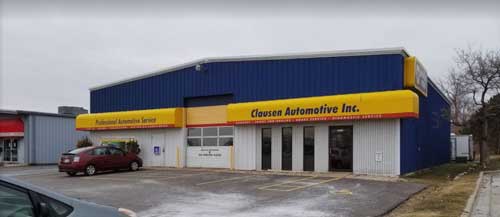Do you feel confident that when your auto mechanic recommends a brake replacement, it is really true? How can he tell if the master cylinder on your brakes has failed? Or is he just trying to push an add-on to the other repairs on your car? How do you know if he is doing his job correctly and looking after your best interests and your safety, rather than taking you for a ride with a brake replacement?
Signs of the Master Cylinder is failing:
- Soft, squishy feeling when you press down on the pedal - As constant pressure is maintained on the pedal (like at a stop light), it will begin to sink to the floor as the brake fluid leaks internally to the master cylinder. This is called "extended travel." You may have to "pump" the pedal to regain normal pressure and keep the car from moving forward as the brakes slowly release. The red warning dash light should come on to indicate low fluid, or excessive movement "travel." The fluid level alone isn’t an indication of a good or bad master cylinder. Typically, the leak is internal, leaking past internal O-rings, so there is no obvious external sign that the master cylinder is "bad."
- An external fluid leak could be possible and would be visible to a mechanic during an under-hood inspection. The master cylinder usually has a plastic reservoir that holds the brake fluid, mounted with rubber grommets. The grommets allow for some movement caused by the pedal and fluid pressures. These grommets can leak brake fluid (a clear liquid) that can be seen with the naked eye.
- The metal brake lines attached to the master cylinder can leak fluid at the threaded connections, or from the internal O-rings. When this happens, the fluid will drip down the power brake booster (the booster is what the master cylinder is bolted to). Brake fluid will dissolve paint rather quickly, so this kind of leak usually leaves a tell-tale sign of blistering, bubbled paint.
If you experience any of the symptoms explained above, check the following:
- Check brake fluid level and add more as needed;
- Make sure the cap fits snuggly and is not leaking or shows obvious signs of past leakage
- Visually inspect for external fluid leaks;
- Wipe away accumulated dirt and debris for ease of future inspections;
- Have your brakes inspected if more than 1 or 2 ounces is needed to top off the reservoir;
- Don’t put off any needed repairs or a brake replacement.
Are you looking for professional advice on your brakes, or need a quality brake replacement? We will be glad to help you. Contact our ASE-Certified Technicians today at Clausen Automotive by calling (608) 221-8321 or go online at https://www.clausenautomotive.com for more information. Since 1975, our family-owned auto shop has proudly served vehicle owners in Madison, WI, and surrounding communities.
Watch the Signs of Master Cylinder Troubleshooting for Brakes! When should your auto mechanic recommend a brake replacement? Contact us today!Do you feel confident that when your auto mechanic recommends a brake replacement, it is really true? How can he tell if the master cylinder on your brakes has failed? Or is he just trying to push an add-on to the other repairs on your car? How do you know if he is doing his job correctly and looking after your best interests and your safety, rather than taking you for a ride with a brake replacement?
Signs of the Master Cylinder is failing:
- Soft, squishy feeling when you press down on the pedal - As constant pressure is maintained on the pedal (like at a stop light), it will begin to sink to the floor as the brake fluid leaks internally to the master cylinder. This is called "extended travel." You may have to "pump" the pedal to regain normal pressure and keep the car from moving forward as the brakes slowly release. The red warning dash light should come on to indicate low fluid, or excessive movement "travel." The fluid level alone isn’t an indication of a good or bad master cylinder. Typically, the leak is internal, leaking past internal O-rings, so there is no obvious external sign that the master cylinder is "bad."
- An external fluid leak could be possible and would be visible to a mechanic during an under-hood inspection. The master cylinder usually has a plastic reservoir that holds the brake fluid, mounted with rubber grommets. The grommets allow for some movement caused by the pedal and fluid pressures. These grommets can leak brake fluid (a clear liquid) that can be seen with the naked eye.
- The metal brake lines attached to the master cylinder can leak fluid at the threaded connections, or from the internal O-rings. When this happens, the fluid will drip down the power brake booster (the booster is what the master cylinder is bolted to). Brake fluid will dissolve paint rather quickly, so this kind of leak usually leaves a tell-tale sign of blistering, bubbled paint.
If you experience any of the symptoms explained above, check the following:
- Check brake fluid level and add more as needed;
- Make sure the cap fits snuggly and is not leaking or shows obvious signs of past leakage
- Visually inspect for external fluid leaks;
- Wipe away accumulated dirt and debris for ease of future inspections;
- Have your brakes inspected if more than 1 or 2 ounces is needed to top off the reservoir;
- Don’t put off any needed repairs or a brake replacement.
Are you looking for professional advice on your brakes, or need a quality brake replacement? We will be glad to help you. Contact our ASE-Certified Technicians today at Clausen Automotive by calling (608) 221-8321 or go online at https://www.clausenautomotive.com for more information. Since 1975, our family-owned auto shop has proudly served vehicle owners in Madison, WI, and surrounding communities.


